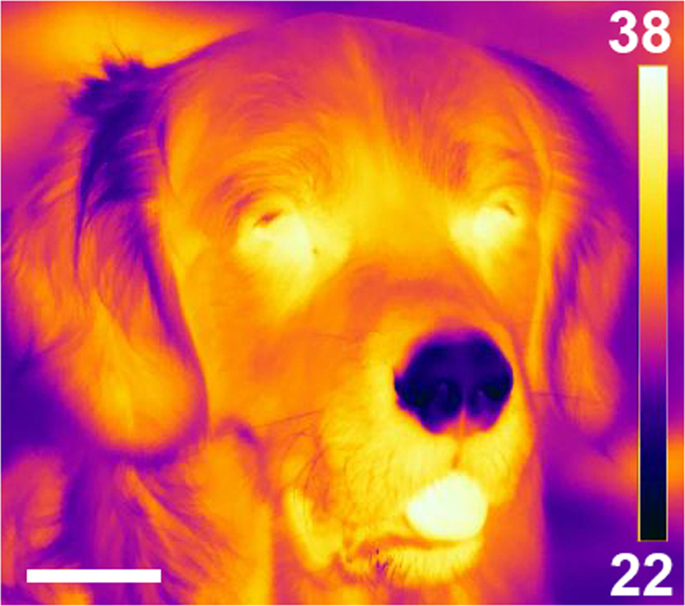Dogs' Residual Ancestral Traits
"The dog rhinarium (naked and often moist skin on the nose-tip) is prominent and richly innervated, suggesting a sensory function. Compared to nose-tips of herbivorous artio- and perissodactyla, carnivoran rhinaria are considerably colder. We hypothesized that this coldness makes the dog rhinarium particularly sensitive to radiating heat. We trained three dogs to distinguish between two distant objects based on radiating heat; the neutral object was about ambient temperature, the warm object was about the same surface temperature as a furry mammal. In addition, we employed functional magnetic resonance imaging on 13 awake dogs, comparing the responses to heat stimuli of about the same temperatures as in the behavioural experiment. The warm stimulus elicited increased neural response in the left somatosensory association cortex. Our results demonstrate a hitherto undiscovered sensory modality in a carnivoran species."
Abstract, Dogs can sense weak thermal radiation, Scientific Reports
 |
| Thermograph of a dog in the shade at 27 °C ambient temperature. The colour scale on the right is in °C and can be used to read out approximate temperatures. Note the warm tongue and the cold rhinarium (hairless nose tip). Scale bar: 50 mm. |
"Dogs are able to sense the thermal radiation coming from warm bodies or weak thermal radiation and they can also direct their behaviour according to this signal."
"We tested whether we can find an area in the brain that shows higher activity if they are exposed to a warmer than to a colder object."
Anna Balint, study lead author
"It is possible that other [carnivores] possess a similar infrared sense and that adds a new chapter to the story of prey-predator relationships."
"Predator hunting strategies have to be re-evaluated and the biology of prey animals has to be revisited with body heat sensing predators in mind."
Ronald Kroger, sensory scientist, Lund University
 |
| Shutterstock |
According to newly-published research in Scientific Reports, a journal published by Nature Research, scientists at Sweden's Lund University in collaboration with Hungary's Eotvos Lorand University found the naked, wet skin surface at the tip of a dog's nose -- full of nerve endings -- has the capacity to act as an infrared sensor.
Brain scans indicated increased brain activity when dogs were shown objects that were warmer than their surroundings. Golden retrievers and Border collies were among the dog breeds tested in this study. To test their theory that dogs' noses have not only an olfactory purpose, but also a capability to sense the presence of warm objects when prey is near, the researchers trained three pet dogs to choose between a warm and an ambient-temperature object.
Where the dogs were unable to see or smell the difference between the two placed 1.6 meters' distant from them, after training the dogs were tested in double-blind experiments which led to all three dogs detecting the objects that emitted weak thermal radiation. The researchers followed up by scanning the brains of 13 pet dogs of different breeds in a functional magnetic resonance imaging (MRI) scanner.
Within the scanner the dogs were presented with objects emitting neutral or weak thermal radiation. It was found that the left somatosensory cortex in dogs' brains delivering inputs from the nose, turned out to be more responsive to the warm thermal stimulus than to the neutral one. Which led the scientists to identify a cluster of 14 voxels (JD pixels) in the region of the dogs' left hemispheres, while no such clusters were found in the right, and none in any part of the dogs' brains in response to the neutral stimulus.
The two experiments in tandem demonstrated that dogs, like vampire bats, are capable of sensing weak hot spots; that a specific brain region becomes activated by this infrared radiation. The scientists feel that dogs likely inherited this trait from their ancestral gray wolf connection who may have used it during hunts to sniff out warm bodies.
"The study is consistent with other research that describes the combined dog nose and brain as a sophisticated platform for processing a broad range of signals."
"[It is doubtful however], that the dog rhinarium can distinguish patterns of hot and cold objects at a distance [suggesting dogs’ thermal detection skills may not be useful for long distance hunting. “[T]hat needs further study.”
Gary Settles, emeritus professor of mechanical engineering, Pennsylvania State University, University Park
 |
An infrared photo of a golden retriever in a functional
magnetic resonance imaging scanner reveals the cold temperature of a
dog’s nose versus its glowing, warm body.
Anna Bálint
|
Labels: Bioscience, Canines, Hunting, Infrared sensor, Research

0 Comments:
Post a Comment
<< Home